中国酒文化英文介绍Chinese wine culture introduction
- 格式:ppt
- 大小:3.34 MB
- 文档页数:26
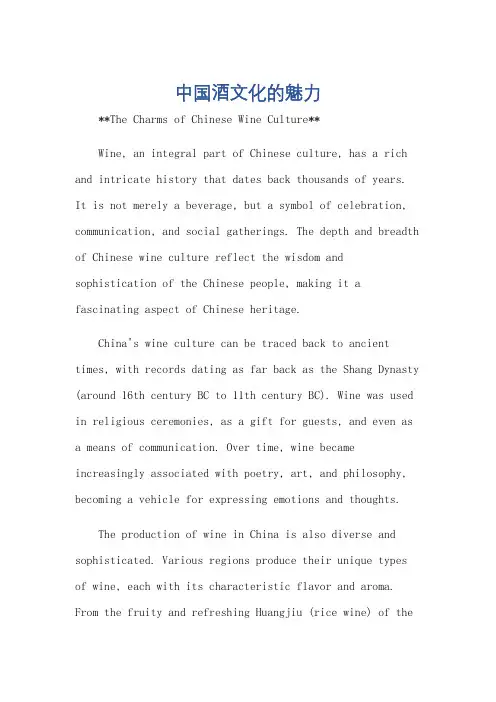
中国酒文化的魅力**The Charms of Chinese Wine Culture**Wine, an integral part of Chinese culture, has a rich and intricate history that dates back thousands of years. It is not merely a beverage, but a symbol of celebration, communication, and social gatherings. The depth and breadth of Chinese wine culture reflect the wisdom and sophistication of the Chinese people, making it a fascinating aspect of Chinese heritage.China's wine culture can be traced back to ancient times, with records dating as far back as the Shang Dynasty (around 16th century BC to 11th century BC). Wine was used in religious ceremonies, as a gift for guests, and even as a means of communication. Over time, wine became increasingly associated with poetry, art, and philosophy, becoming a vehicle for expressing emotions and thoughts.The production of wine in China is also diverse and sophisticated. Various regions produce their unique types of wine, each with its characteristic flavor and aroma. From the fruity and refreshing Huangjiu (rice wine) of thesouth to the robust and earthy Baijiu (liquor) of the north, Chinese wines offer a wide range of tastes and experiences. The consumption of wine in China is also deeply ingrained in social customs and traditions. Wine is often served during festivals, weddings, and other special occasions as a symbol of joy and unity. The art of toasting, or "ganbei" in Chinese, is an integral part of any social gathering, with the clinking of glasses and the shouted phrase being a symbol of friendship and good wishes.Moreover, wine in China is not just a beverage; it is also a vehicle for cultural exchange and understanding. As China opens its doors to the world, its wines are increasingly being exported and enjoyed by people from all over the globe. Through wine, people from differentcultures can come together and appreciate the rich tapestry of Chinese culture.In conclusion, Chinese wine culture is a vibrant and diverse expression of the country's rich heritage and traditions. It is a testament to the Chinese people's loveof life, their appreciation for beauty, and theirdedication to preserving and sharing their culture with theworld. As the world continues to explore and appreciate Chinese wine, it also gains a deeper understanding of the intricate and fascinating culture that surrounds it.**中国酒文化的魅力**酒,作为中国文化的重要组成部分,拥有数千年的丰富而复杂的历史。
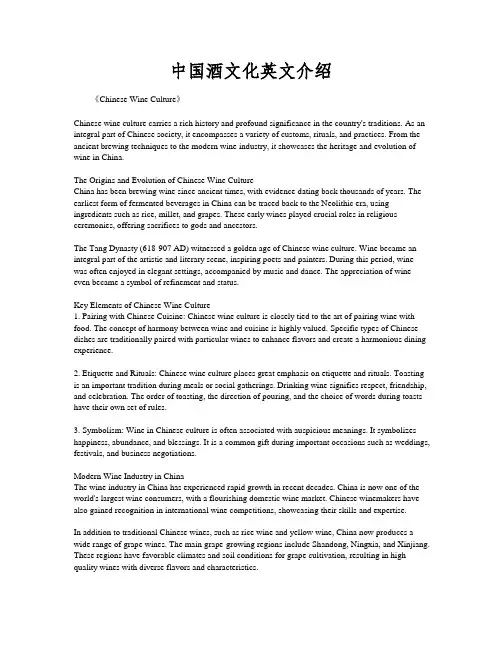
中国酒文化英文介绍《Chinese Wine Culture》Chinese wine culture carries a rich history and profound significance in the country's traditions. As an integral part of Chinese society, it encompasses a variety of customs, rituals, and practices. From the ancient brewing techniques to the modern wine industry, it showcases the heritage and evolution of wine in China.The Origins and Evolution of Chinese Wine CultureChina has been brewing wine since ancient times, with evidence dating back thousands of years. The earliest form of fermented beverages in China can be traced back to the Neolithic era, using ingredients such as rice, millet, and grapes. These early wines played crucial roles in religious ceremonies, offering sacrifices to gods and ancestors.The Tang Dynasty (618-907 AD) witnessed a golden age of Chinese wine culture. Wine became an integral part of the artistic and literary scene, inspiring poets and painters. During this period, wine was often enjoyed in elegant settings, accompanied by music and dance. The appreciation of wine even became a symbol of refinement and status.Key Elements of Chinese Wine Culture1. Pairing with Chinese Cuisine: Chinese wine culture is closely tied to the art of pairing wine with food. The concept of harmony between wine and cuisine is highly valued. Specific types of Chinese dishes are traditionally paired with particular wines to enhance flavors and create a harmonious dining experience.2. Etiquette and Rituals: Chinese wine culture places great emphasis on etiquette and rituals. Toasting is an important tradition during meals or social gatherings. Drinking wine signifies respect, friendship, and celebration. The order of toasting, the direction of pouring, and the choice of words during toasts have their own set of rules.3. Symbolism: Wine in Chinese culture is often associated with auspicious meanings. It symbolizes happiness, abundance, and blessings. It is a common gift during important occasions such as weddings, festivals, and business negotiations.Modern Wine Industry in ChinaThe wine industry in China has experienced rapid growth in recent decades. China is now one of the world's largest wine consumers, with a flourishing domestic wine market. Chinese winemakers have also gained recognition in international wine competitions, showcasing their skills and expertise.In addition to traditional Chinese wines, such as rice wine and yellow wine, China now produces a wide range of grape wines. The main grape-growing regions include Shandong, Ningxia, and Xinjiang. These regions have favorable climates and soil conditions for grape cultivation, resulting in high-quality wines with diverse flavors and characteristics.ConclusionThe book《Chinese Wine Culture》 unveils the fascinating history, customs, and rituals behind China's wine culture. From ancient rituals to modern winemaking, it invites readers to explore the rich heritage and diverse flavors of Chinese wines. With its unique traditions and profound symbolism, Chinese wine culture continues to thrive and captivate both domestic and international audiences.。
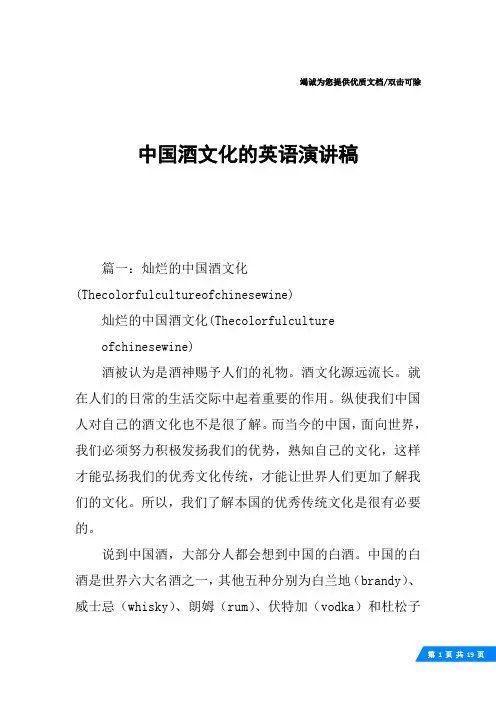
竭诚为您提供优质文档/双击可除中国酒文化的英语演讲稿篇一:灿烂的中国酒文化(Thecolorfulcultureofchinesewine)灿烂的中国酒文化(Thecolorfulcultureofchinesewine)酒被认为是酒神赐予人们的礼物。
酒文化源远流长。
就在人们的日常的生活交际中起着重要的作用。
纵使我们中国人对自己的酒文化也不是很了解。
而当今的中国,面向世界,我们必须努力积极发扬我们的优势,熟知自己的文化,这样才能弘扬我们的优秀文化传统,才能让世界人们更加了解我们的文化。
所以,我们了解本国的优秀传统文化是很有必要的。
说到中国酒,大部分人都会想到中国的白酒。
中国的白酒是世界六大名酒之一,其他五种分别为白兰地(brandy)、威士忌(whisky)、朗姆(rum)、伏特加(vodka)和杜松子酒(gin)。
外国友人在第一次品尝中国酒的时候都会很谨慎。
然而,只要他们尝过一两次,就会爱上各式的酒,并且开始享受饮酒的乐趣。
1、关于中国酒起源的传说(TheFairyTaleoftheoriginofchinesewine)我们的祖先放弃了她们的游牧生活,选择在黄河流域群居的时候,种植了多种多样的谷物,这为日后酿造美酒奠定了基础。
据说中国的酿酒技术始于夏朝。
仪狄和杜康,被认为是中国造酒业的鼻祖。
据史料记载,仪狄应君主禹的要求,付出了巨大的努力,终于成功地用发酵的糯米酿造出了芳醇的美酒。
生活在夏朝的杜康,凭借用高粱酿造出的美酒,而受到赞誉。
据史料记栽,冬日里的一天,杜康将一些煮过的高粱米放到了树洞里。
第二年春天,从这个树洞里散发出浓浓的香味,扑鼻而入。
之后,杜康发现正是发酵的高粱米散发出诱人的香气。
这个偶然的发现给了他用发酵的高粱米酿酒的灵感。
2、中国的国酒(ThenationalLiquor)——茅台(maotai)在重大历史事件中,如日内瓦会谈、中美建交,茅台酒都是打破历史坚冰的特殊利器。
党和国家领导人多次将茅台作为“国家级礼品”赠送给外国领导人。
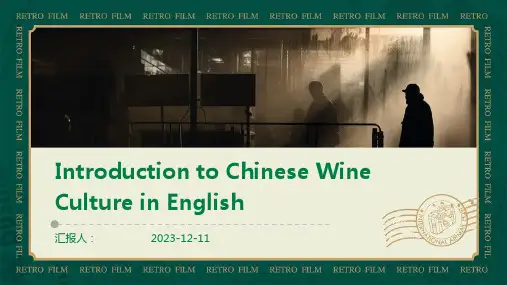
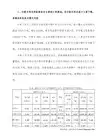
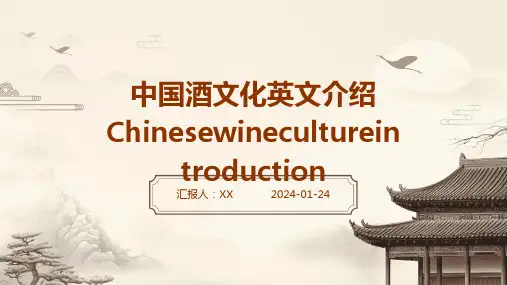
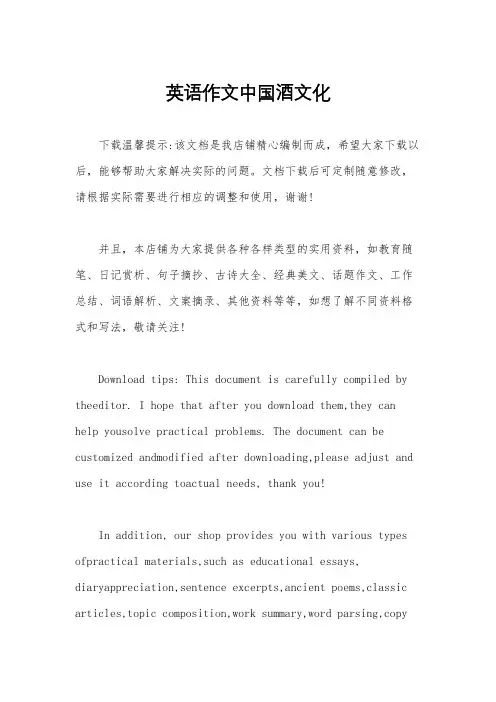
英语作文中国酒文化下载温馨提示:该文档是我店铺精心编制而成,希望大家下载以后,能够帮助大家解决实际的问题。
文档下载后可定制随意修改,请根据实际需要进行相应的调整和使用,谢谢!并且,本店铺为大家提供各种各样类型的实用资料,如教育随笔、日记赏析、句子摘抄、古诗大全、经典美文、话题作文、工作总结、词语解析、文案摘录、其他资料等等,如想了解不同资料格式和写法,敬请关注!Download tips: This document is carefully compiled by theeditor. I hope that after you download them,they can help yousolve practical problems. The document can be customized andmodified after downloading,please adjust and use it according toactual needs, thank you!In addition, our shop provides you with various types ofpractical materials,such as educational essays, diaryappreciation,sentence excerpts,ancient poems,classic articles,topic composition,work summary,word parsing,copyexcerpts,other materials and so on,want to know different data formats andwriting methods,please pay attention!China is a country with a rich and diverse culture, and one aspect of this culture that stands out is its wine culture. Chinese wine culture dates back thousands of years and has its own unique characteristics.In China, wine is not just a drink, but also a symbol of social status and a way to show hospitality. When hosting guests, it is common for the host to offer a glass of wine as a gesture of welcome. Wine is also often used in traditional ceremonies and rituals, such as weddings and festivals.Chinese wine is made from a variety of ingredients, including rice, grapes, and other fruits. Each region in China has its own specialty wine, with different flavors and aromas. For example, Shaoxing wine from Zhejiang province is known for its mellow and rich taste, while Maotai from Guizhou province has a strong and distinctive flavor.Drinking wine in China is not just about the taste, but also about the experience. Traditional Chinese winedrinking etiquette is quite different from that of Western countries. For example, it is common to toast with a small cup rather than a large glass, and it is considered polite to leave a small amount of wine in the cup as a sign of respect.In recent years, the popularity of wine in China has been growing rapidly. With the rise of the middle class, more and more people are becoming interested in wineculture and learning about different types of wine. Wine bars and wine tasting events have become increasingly popular in major cities, offering people the opportunity to explore and appreciate the world of wine.However, it is important to note that wine culture in China is not without controversy. Excessive drinking and alcohol-related problems have become a concern in recent years. The government has implemented measures to regulate the production and consumption of wine, including stricterenforcement of drunk driving laws and campaigns promoting responsible drinking.In conclusion, Chinese wine culture is a fascinating and integral part of the country's rich heritage. From the traditional rituals to the modern wine bars, wine plays a significant role in Chinese society. Whether you are a wine connoisseur or simply curious about different cultures, exploring Chinese wine culture is sure to be an interesting and rewarding experience.。
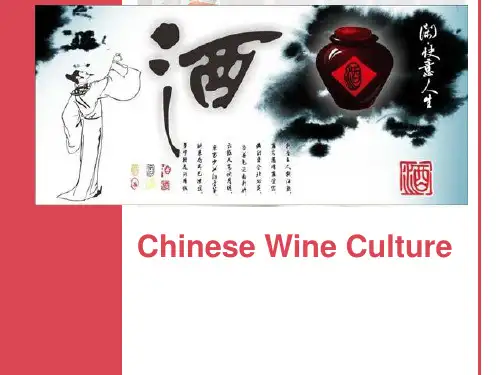

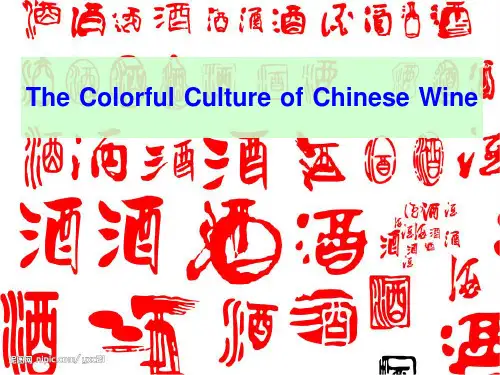
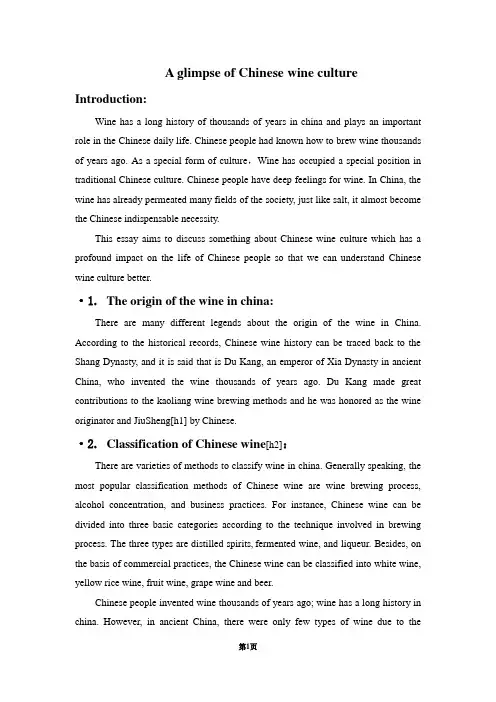
A glimpse of Chinese wine culture Introduction:Wine has a long history of thousands of years in china and plays an important role in the Chinese daily life. Chinese people had known how to brew wine thousands of years ago. As a special form of culture,Wine has occupied a special position in traditional Chinese culture. Chinese people have deep feelings for wine. In China, the wine has already permeated many fields of the society, just like salt, it almost become the Chinese indispensable necessity.This essay aims to discuss something about Chinese wine culture which has a profound impact on the life of Chinese people so that we can understand Chinese wine culture better.·1. The origin of the wine in china:There are many different legends about the origin of the wine in China. According to the historical records, Chinese wine history can be traced back to the Shang Dynasty, and it is said that is Du Kang, an emperor of Xia Dynasty in ancient China, who invented the wine thousands of years ago.Du Kang made great contributions to the kaoliang wine brewing methods and he was honored as the wine originator and JiuSheng[h1]by Chinese.·2. Classification of Chinese wine[h2]:There are varieties of methods to classify wine in china. Generally speaking, the most popular classification methods of Chinese wine are wine brewing process, alcohol concentration, and business practices. For instance, Chinese wine can be divided into three basic categories according to the technique involved in brewing process. The three types are distilled spirits,fermented wine, and liqueur. Besides, on the basis of commercial practices, the Chinese wine can be classified into white wine, yellow rice wine, fruit wine, grape wine and beer.Chinese people invented wine thousands of years ago; wine has a long history in china. However, in ancient China, there were only few types of wine due to thelimited brewing technology and low output of grain. People made the wine based on their experience and the wine production scale was relatively small. Later along with the development of distilling and brewing techniques, wine has become a more ordinary drink in china and more and more varieties of wine have been brewed, as well as many customs concerning wine.Nowadays, Top Ten Famous Liquor[h3] in China includes Kweichow Maotai Liquor,Wu Liang Y e liquor, Y anghe Daqu, Luzhou Laojiao Tequ Liquor, Xinghuacun Fen Liquor, Gujing Tribute Liquor, Gulin Lang Liquor, Shuanggou Daqu Liquor, Mianzhu Jiannanchun Liquor and Xifeng Liquor. With the advanced brewing technology and a long history,Mao-tai Liquor has been regarded as the national liquor of china. Reputed as the “National Liquor” of China,Maotai Liquor is worldwide renowned for its characteristics,such as its pure and transparent color, mellow and strong fragrance, soft and smooth taste, cool and refreshing flavor, long and lingering aftertaste.·3. The usage of Chinese wine:In ancient china, the production of wine is limited due to the immature brewing technology. Consequently, wine was mainly used as sacrificial offerings to Heaven, Earth or ancestors. But now, with many special features, the wine has been used in many areas of Chinese society.As an important traditional beverage, wine is almost treated as an essential beverage used at a variety of banquets. In addition, the wine, especially yellow rice wine can also be used to cook. Wine contributes greatly to removing the fishy smell which often makes people feel sick, and wine can make the dish more fragrant and tastier. For example, so delicious the braised fish which cooked with wine in China is, that it welcomed by people, both Chinese and foreign tourists.Apart from the above functions, the wine can also promote human blood circulation. As a result, it is helpful for people to maintain beauty and keep young according to the medical theory. It is believed that drinking the moderate amount of wine benefit the human body. In addition, Chinese medicine practitioners have usedthe medicinal liquor to treat some diseases for thousands of years.·4. Several important Chinese drinking etiquettes and customs: Chinese drinking etiquettes and customs appeared as soon as the wine was invented. As with Chinese wine, the Chinese wine drinking etiquettes and customs has been inherited from our ancestors for a long period,and some etiquettes and customs have survived until today. Generally speaking, when it comes to Chinese drinking etiquettes and customs, it mainly refers to “Wine Feast” and “Drinkers’ Wager Game”. ·4.1 Wine Feast:In china, in order to express their sincerity and friendship, the hosts like urging their guests to drink more at the wine feast. [There are all kinds of reasons for Chinese to hold wine feasts, such as opening a business, festival celebrations, and wedding banquet]. [h4] Several important wine feasts in china are as follows:·4.1.1“Arm-Crossed Wine” at the wedding ceremonyAt the wedding ceremony, the newlyweds will each take a glass of wine, and the bride and bridegroom would drink from the other's cup to show affection and love to each other.·4.1.2 “Month-old wine feasts” and “Hundredth –day wine feasts”The two wine feasts are held respectively when a baby is a month or hundred days old, relatives and friends would be invited to have dinners at the child’s home. To express their best wishes, [guests put gifts or wrap money inside a small red paper envelope which called a “red packet”, for the child’s family]. [h5]·4.1.3 “Longevity wine feasts” [h6]Longevity wine feasts are regarded as birthday feasts which prepared for elders in the family. The fiftieth, sixtieth and seventieth birthday are entitled to great birthday celebration, which are usually celebrated by his or her children or grandchildren with bumper feast.· 4.1.4 “Beam-placed-on-the-roof wine feasts”In China, the beam placed on the roof is a very important ceremony; hence,Chinese people would like to hold a banquet to celebrate this exciting moment. ·4.2 Drinkers’ Wager Game:Chinese hospitality is fully expressed at wine feasts or dinners. As a Way of entertainment at wine feasts, the drinkers’ wager game are viewed as a penalty to urge drinkers to drink more, but the chief purpose of the d rinkers’ wager game is regarded as a special way to help create more joyous atmosphere while drinking. Many d rinkers’ wager games have been playing by Chinese. The most common and simplest d rinkers’ wager game is called “finger-guessing game” which played by two drinkers. ·5.Wine and arts:Wine has an unbelievable effect on literary and artistic creation. As a particular beverage, it is loved deeply by artists in china. Wine has helped artists achieve an uninhibited state of mind, which stirring their creativity, as a result, many of artists produced their best masterpieces in a state of drunkenness. For example, the two famous poets, Li Bai and Du Fu, they worked the best poetries when they drunk a lot of wine.Conclusion:As we know, wine has been occupying an irreplaceable position in Chinese culinary culture, whether in ancient or modern times. Wine has witnessed the rise and fall of history in China for thousands of years. As a particular form of culture, wine has a profound influence on Chinese culture and it makes the Chinese people's life more colorful.However, every coin has two sides; wine also can cause some negative influence on the society in China. Chinese love drinking wine very much. Absolutely drinking moderate amount of alcohol is good, however, excessive drinking is not only bad for health, but sometimes can also cause serious consequences, like drunken driving. In China, each year there were many people have been killed in car accident and a large rate of the accidents are caused by drunken driving. Therefore, to express the feelings of love for wine in a more reasonable way is very necessary. Only in this way can we make Chinese wine culture to be healthier.References1.Liao, H .Y. et al. A glimpse of Chinese culture [M].beijing:foreing languageteching and research press.2007. [h4]h[5][h6].2.李书林. 中国酒的分类[J]. 商场现代化. 1985.[h2]3.罗启荣等.中国酒文化大观.[M].广西民族出版社.2002.4.王鲁地等.中国酒文化赏析.[M]. 山东大学出版社.2008.5.杜康./view/29265.htm#2;[h1]6.Chinese wine 中国名酒/language/english/chineseculture/article/2011-06/20/conten t_313827.htm.[h3].。
中国酒文化英文作文英文:As a Chinese person, I am very proud of our country's rich and diverse culture, including our unique wine culture. China has a long history of wine production, dating back to the Shang Dynasty over 3,000 years ago. Today, Chinese wine has become increasingly popular both domestically and internationally.One of the most famous types of Chinese wine is baijiu, a strong distilled spirit made from grain. It is often consumed during important events and celebrations, such as weddings and business banquets. Another popular type of Chinese wine is huangjiu, a traditional fermented rice wine that is often served warm. It is commonly enjoyed withmeals and is said to have health benefits.In addition to these traditional wines, China has also been producing more Western-style wines in recent years.Regions such as Ningxia and Shandong have become known for their high-quality wines, winning awards at international competitions.Overall, China's wine culture is an important part of our heritage and continues to evolve and grow. It is a reflection of our country's rich history and diverseculinary traditions.中文:作为一位中国人,我为我们国家丰富多彩的文化感到自豪,其中包括我们独特的酒文化。
英语作文中国酒文化英文:China has a rich and diverse culture when it comes to alcohol. Chinese people have been making and drinkingalcohol for thousands of years, and it has become anintegral part of their social and cultural life. 。
One of the most famous alcoholic beverages in China is baijiu, which is a strong distilled spirit usually madefrom sorghum, rice, or other grains. Baijiu is often consumed during important social occasions such as weddings, business banquets, and family gatherings. It is also a popular choice for toasting and celebrating.In addition to baijiu, China also has a long history of producing and consuming various types of rice wine, such as huangjiu and mijiu. These traditional rice wines are often enjoyed during festivals and special events, and they are believed to have medicinal properties as well.The Chinese have a saying, "酒逢知己,千杯少", which means "A thousand cups of wine is not too much when shared with a bosom friend." This reflects the importance of alcohol in building and strengthening relationships in Chinese culture. Drinking together is seen as a way to bond and create trust between friends and colleagues.Moreover, the art of drinking in China involves a lot of customs and rituals. For example, when pouring a drink for someone else, it is customary to hold the bottle with both hands as a sign of respect. Toasting is also an important part of Chinese drinking culture, and it is considered impolite to refuse a toast from someone of higher status.In recent years, the popularity of Chinese alcohol has been growing internationally, with baijiu gaining recognition as a unique and flavorful spirit. Many people around the world are becoming interested in learning about the history and culture behind Chinese alcohol.中文:中国有着丰富多彩的酒文化。
中国酒文化的英文作文"English:"China boasts a rich and diverse culture, and its tradition of alcohol consumption is deeply embedded in its history. Chinese alcohol culture encompasses a wide range of beverages, including baijiu, huangjiu, and various types of rice wine, each with its own unique flavor profile and brewing techniques.One of the most iconic aspects of Chinese alcohol culture is baijiu, a strong distilled spirit typically made from sorghum or other grains. Baijiu is often enjoyed during celebratory occasions, such as weddings and business banquets, where toasts are exchanged as a sign of respect and camaraderie. The saying "ganbei," meaning "bottoms up," is commonly heard during these festivities, encouraging everyone to empty their glasses in unison.Another prominent feature of Chinese alcohol culture isthe concept of "g ānx ì," which translates to "building relationships through drinking." In Chinese business culture, it's not uncommon for deals to be brokered over glasses of baijiu, as sharing a drink is seen as a way to foster trust and strengthen bonds between colleagues and clients. Refusing a drink can sometimes be considered impolite or even disrespectful, as it may be interpreted as rejecting the opportunity to connect on a personal level.Aside from baijiu, huangjiu, or yellow rice wine, holds a special place in Chinese culinary traditions. This sweet, fermented beverage is often used in cooking to enhance the flavors of various dishes, particularly in dishes from the Jiangnan region, such as drunken chicken or fish. Additionally, huangjiu is enjoyed on its own, eitherchilled or warmed, depending on the season and personal preference.Furthermore, Chinese alcohol culture extends beyondjust the beverages themselves to the vessels in which they are served. Ornate cups and decanters are often used during formal occasions, adding a touch of elegance to thedrinking experience. Conversely, simple ceramic or glass cups are more common for casual gatherings among friends and family, where the focus is more on enjoying eachother's company than on the presentation of the alcohol.In summary, Chinese alcohol culture is deeply rooted in tradition and plays a significant role in social interactions and celebrations. Whether it's raising a glass of baijiu to toast a special occasion or sharing a bottle of huangjiu over a meal, alcohol serves as a symbol of camaraderie and hospitality in Chinese society."中文,"中国拥有丰富多彩的文化,其酒文化传统深深扎根于其历史之中。
酒文化英语演讲稿篇一:中国酒文化 Chinese Wine Culture1、中国酒文化 Chinese Wine Culture中国人在7000年以前就开始用谷物酿酒。
总的来说,不管是古代还是现代,酒都和中国文化息息相关。
长久以来,中国的酒文化在人们生活中一直扮演着重要的角色。
我们的祖先在写诗时以酒助兴,在宴会中和亲朋好友敬酒。
作为一种文化形式,酒文化也是普通百姓生活中不可分割的部分,比如生日宴会、送别晚宴、婚礼庆典等。
Chinese people began to make spirits with grains seven thousand years ago. Generally speaking,wine has a close connection with culture in China in both ancient and modern times. Chinese wine culture has been playing a quite important role in Chinese people's life for a long time. Our Chinese ancestors used wine to enjoy themselves while writing poetry, or to make a toast to their relatives and friends during a feast. Wine culture, as a kind of culture form, is also an inseparable part in the life of ordinary Chinese people such as birthday party, farewell dinner, wedding, etc.2、中国书法Chinese Calligraphy中国书法历史悠久,它不仅是汉字的传统书写形式,也是体现自我修养和自我表达的艺术。
关于中国酒文化的英语作文(中英文实用版)Title: The Culture of Chinese LiquorThe culture of Chinese liquor, deeply rooted in the nation"s history, is an integral part of China"s rich cultural heritage.It reflects the social etiquette, artistic expression, and philosophical thoughts of the Chinese people over thousands of years.Chinese liquor, often referred to as "Baijiu," is diverse in its forms, flavors, and production methods.It is made from various ingredients such as grain, including rice, wheat, and sorghum.The fermentation and distillation processes are meticulous and time-consuming, reflecting the craftsmanship and dedication of Chinese brewers.The consumption of Baijiu is not just about imbibing alcohol; it is a significant part of social interactions and ceremonies.In China, offering a toast is a way to show respect, build relationships, and foster goodwill.During formal dinners, guests are expected to participate in the toast, which involves a series of rituals.For instance, when toasting to elders or superiors, one should hold their glass lower than the other person"s as a sign of respect.Moreover, Chinese literature and art are filled with references to liquor.Poets like Li Bai and Du Fu often mentioned the pleasures and pains of drinking in their works.The famous Chinese painting "Drunken Beauty"by Gu Kaizhi illustrates the elegant and carefree demeanor of a woman in a state of tipsiness.Chinese liquor is also closely tied to traditional festivals.During the Spring Festival, it is customary to drink Baijiu as a way to celebrate the coming of a new year and wish for good fortune.In the Mid-Autumn Festival, drinking moonshine while appreciating the full moon is a cherished tradition.In recent years, the Chinese liquor industry has seen a revival, with many distilleries adopting traditional methods while embracing modern technology.The government has also recognized the importance of protecting and promoting the cultural heritage of Chinese liquor, naming certain brands as intangible cultural heritage.In conclusion, the culture of Chinese liquor is a multifaceted reflection of China"s historical, social, and artistic identity.It is not merely a drink but a symbol of the nation"s traditions and values.---标题:中国酒文化中国酒文化,根植于国家的历史之中,是中国丰富文化遗产的重要组成部分。